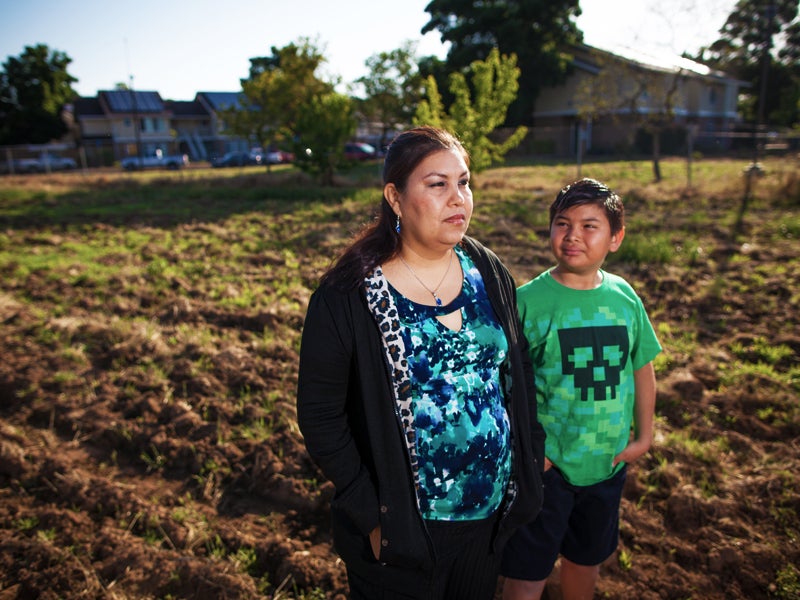Chlorpyrifos Damaged My Son’s Brain for Life
The Trump administration may like questioning solid science, but those who have harvested crops in the fields are well aware that the pesticide chlorpyrifos is too toxic to be used on our fruits and vegetables.

This page was published 7 years ago. Find the latest on Earthjustice’s work.
This is a guest blog post by Claudia Angulo, a 38-year-old mother of four who lives in California’s San Joaquin Valley.
This blog post was originally published in March 2017. It has been updated to reflect that one year later, the EPA still has not banned chlorpyrifos.
The Trump administration may like questioning solid science, but those of us who have harvested crops in the fields are well aware that the pesticide chlorpyrifos is too toxic to be used on our fruits and vegetables. I became aware of the dangers of chlorpyrifos soon after I started working in California in the mid-1990s, when I saw a plane accidentally spray pesticides onto a group of workers. Some were pregnant women and they immediately became very sick. Firefighters rushed them to the hospital, but all of the women still lost their babies.
The Trump administration may like questioning solid science, but those of us who have harvested crops in the fields are well aware that the pesticide chlorpyrifos is too toxic to be used on our fruits and vegetables.
I was 17 years old when that event occurred, and although I learned from the experience that pesticides are harmful, I didn’t understand just how terrible these toxic chemicals can be until my son, Isaac, was born with a mental disability. No one—not even the doctors—could explain why Isaac was born with intellectual disability and attention deficit hyperactivity disorder (ADHD). But I was already suspicious about pesticides, so I did my research. I quickly learned that, according to many studies, coming in contact with chlorpyrifos during pregnancy is linked to developmental problems in children, as well as autism. I’m sure this is what happened to us. I am sure that chlorpyrifos damaged my son’s brain for life.
I didn’t understand just how terrible these toxic chemicals can be until my son, Isaac, was born with a mental disability.
While pregnant, I worked in food processing, sorting oranges, mandarins, lemons, apples, broccoli and other products mainly treated with chlorpyrifos. There were about nine other pregnant women on my team, and I was the last to give birth in 2006. Over the years, I’ve learned that four of those nine women also had children with ADHD. Two other babies born to women in the group had heart problems, and two more were born with respiratory problems and a skin disease called eczema.
Two years ago, I received yet more evidence of the lasting damage pesticides have done to my family. In late 2015, European journalists working on a documentary took some of Isaac’s hair to test in a laboratory. According to the results, my son had traces of more than 50 pesticides in his body. The one with highest concentration was chlorpyrifos. Of all the children studied, Isaac showed the greatest exposure to pesticides because of my contact with pesticides before he was born and because he still lives and goes to school very close to farm fields. The second most impacted child was a boy from Hawai’i who had traces of 27 pesticides in his body. The root of my son’s illness is clear to me.
The pesticide test results scared me very much. I live in Orange Cove, California, surrounded by agriculture, though I no longer work in the plant or in fields that have pesticides. There are still countless sons and daughters of field workers and rural families living with as many, if not more problems than Isaac and who are still being constantly poisoned by pesticides.
Since Isaac’s diagnosis, I have worked tirelessly to raise awareness among farmworkers, the public and politicians about the effects of chlorpyrifos on the health of our communities, and especially on the families of workers who handle these chemicals on a daily basis. After diligent work, I finally thought the EPA would approve a proposal from the agency’s own scientists to ban chlorpyrifos from the market. Many advocates like me thought it was bound to happen, since the EPA recently said that any exposure to chlorpyrifos from food is unhealthy. But it’s been a year since EPA Administrator Scott Pruitt decided not to ban chlorpyrifos after all, claiming that the science is “unresolved.” This move is inconceivable
That the head of the EPA would rather put our country’s health at risk than protect us from preventable illnesses makes me very angry. Chlorpyrifos was banned almost 20 years ago from household products because it was deemed too dangerous for children. So how can this toxic pesticide still be used on food crops? Ultimately, these same crops are hand-picked by farmworkers and eaten by kids.
To know that thousands of unborn babies are at risk of preventable conditions is disturbing. But hope is the last thing to die. I, for one, am committed to continuing the fight because if we as parents don’t fight to protect our children’s health, no one will. It might take more work and more time, but I’m sure we’ll get the support of the authorities and that we will soon ban chlorpyrifos from our food for good.
Established in 1987, Earthjustice's Northwest Regional Office has been at the forefront of many of the most significant legal decisions safeguarding the Pacific Northwest’s imperiled species, ancient forests, and waterways.